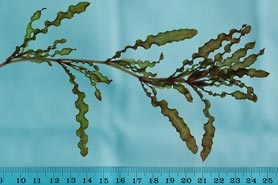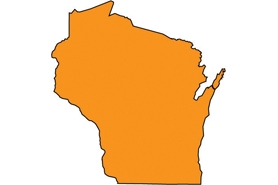Curly-leaf pondweed
(Potamogeton crispus)
Curly-leaf pondweed is a submersed aquatic plant native to Eurasia, Africa, and Australia. It was first verified in North America in the 1840s and quickly spread throughout the Northeast and Great Lakes regions into the early 1900s. Curly-leaf pondweed typically reproduces via turions (i.e., vegetative propagules), generally formed in late spring and early summer. The plant naturally dies back soon after turion formation, and the turions remain dormant in the sediment during the remainder of the summer and early fall. When water temperatures cool, the turions germinate (i.e., start growing). While a small number of turions may germinate in the fall (and survive under the ice during the winter), the majority of the turions will germinate the following spring. Curly-leaf proliferates once water temperatures reach 50⁰F (10⁰C).
Other names for this plant include:
- Common names: curly pondweed, curled pondweed, crisped pondweed
Classification in Wisconsin: Restricted
- Ecological and Socio-economic Impacts
-
- In some waterbodies, curly-leaf pondweed can form extensive mats that impede recreational activities like fishing, boating, and swimming.
- The midsummer die-off of curly-leaf pondweed releases phosphorus into the water column as it decomposes, which can potentially cause algae to bloom in some lakes. The algae then decompose and use oxygen, possibly leading to a dissolved oxygen crash. However, the impacts from the curly-leaf pondweed die-off on water quality and phosphorus load (i.e., the amount of phosphorus entering a lake) are highly variable depending on the lake’s watershed, nutrient composition and depth.
- Curly-leaf pondweed can also provide benefits to the ecosystem. In highly degraded or otherwise turbid sites where other plants cannot survive, curly-leaf pondweed may provide essential ecosystem services (e.g., food, habitat, spawning substrate) for native animals that would otherwise be unavailable.
- Identification
-
Leaves: Submersed alternate leaves that are typically ½ to 3 ½ inches long and ¼ ¬to ½ inch wide. The leaves are wavy, like lasagna noodles, and have a distinctly serrated edge. Young plants may have more flattened leaves but will still have visible serration along the leaf edge.
Flowers: Tiny, with four petal-like lobes, arranged in ½- to 1-inch-long spikes on stalks up to 3 inches long.
Reproductive structures: Short (½ to 1 inch), bur-like hardened turions.
Roots: Fibrous from slender rhizomes.
Similar species: Many native Potamogeton species are native to Wisconsin; lookalikes include Richardson’s pondweed (Potamogeton richardsonii) and white-stemmed pondweed (Potamogeton praelongus).
- Distribution
-
See the reported locations of curly-leaf pondweed in Wisconsin.
Do you know of other populations? Please send us a report.
- Control
-
Prevention: The best way to keep a lake free of curly-leaf pondweed is to prevent its establishment. Wisconsin’s invasive species law prohibits the transport of aquatic plants, live animals and water from a waterbody, with some exceptions for bait.
- Before leaving the boat launch, conduct the following actions required by law:
- Inspect and remove aquatic plants and animals from boats and equipment.
- Drain all water from the boat and equipment.
- Before entering another waterbody
- Spray boat and equipment with high-pressure hot water, or
- Allow the boat and equipment to dry out of water for at least five days.
Mechanical: Mechanical harvesting will not eradicate curly-leaf pondweed, but it can help mitigate recreational and navigational impairments for a single season. Harvesting will also remove plant biomass from the waterbody, which eliminates the phosphorus stored in the plants from the lake system; however, this will only be impactful if curly-leaf pondweed is a significant contributor to the lake’s phosphorus load (i.e., the amount of phosphorus entering a lake). Mechanical harvesting of aquatic plants can also potentially impact non-target native plants and result in the accidental removal of fish and other marine organisms.
Chemical: Chemical management requires multiple years of early season applications to deplete the turion bank, which is expensive and has not succeeded in achieving eradication or maintaining control over the long term. Chemical applications can also cause phosphorus release into the water column as the plants die back. Chemical management conducted in early spring when plant biomass is low and water temperatures are cool may help minimize nutrient release. An approved Chapter NR 107 permit is required to use herbicides in a Wisconsin waterbody to control aquatic plants.
Endothall is the most commonly used herbicide for controlling curly-leaf pondweed. While small-scale chemical treatments are often proposed to control curly-leaf pondweed, they are not recommended for endothall because the chemical dissipates too quickly away from targeted treatment areas to effectively manage curly-leaf pondweed. The manufacturer of endothall has recommended that endothall treatments be more significant than 5 acres for effective curly-leaf pondweed control.
- Before leaving the boat launch, conduct the following actions required by law:
- Resources
- Links for more information:



